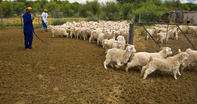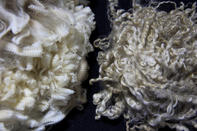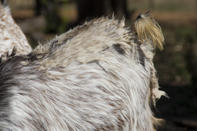The small Angora goat is originally from the Middle Eastern region of Turkey. The first animals - one doe (female) and 12 bucks (male) - were imported to South Africa in 1838, but it was found that all the bucks were rendered sterile.

Fortunately, the doe was pregnant and gave birth to a ram kid. More animals were imported to South Africa between 1857 and 1868 until the sultan of Turkey stopped exports. The Angora Goat Breeders' Society was established in 1892 and is known today as the Angora Ram Breeders. Mohair is produced on approximately 1000 Angora goats farms around South Africa.
There are about 700 farms big enough to be considered ‘commercial producers', while the remaining 300 are smaller producers. Once the goats have been shorn the hair is taken to Nelson Mandela Bay by the brokers who sell the fibre (hair) at auction.
Mohair from across South Africa, is brought to Nelson Mandela Bay (Port Elizabeth area in the Eastern Cape province) where it is processed. Port Elizabeth harbour is the only port exporting mohair from South Africa.
Textiles from Goats

Angora goats in South Africa are bred for mohair production. Mohair is a strong elastic fibre that is warm, lightweight and durable, and can be easily dyed. It is mainly used in the textile industry for clothing, knitwear (hand and machine knitting), curtaining, upholstery material, and blankets.
Mohair is different from wool in that it has a much smoother surface and a very thin, smooth scale. An Angora goat can produce up to 5 kg of mohair and needs to be sheared twice a year as it grows between 12 - 15 cm every six months.
Angora fleece should be uniform with regard to length and fineness, it should show a good lustre, solid style and good character and be free from coloured and kemp fibres. (Kemp fibres are white, brittle weak fibre often mixed in with the normal fleece of an animal).
Quality mohair comes in two basic styles - spiral-shaped and flat wavy locks - and is typically sold in three grades: fine, medium and strong. The grade is determined largely by the age of the Angora goat. Mohair production is often combined with the production of goat meat to ensure cash flow throughout the year.
Meat quality from young goats is of a good quality but the carcasses are smaller and thinner than those of sheep that have been fed in a similar manner.

Cashmere, produced from the soft inner hair of a goat’s coat, is produced on a small scale from iMbuzi goats near Butterworth in the Eastern Cape. Over 300 small farmers collect the inner hair of the goat’s coat.
This is bought by Ivili Loboya and processed into textiles and garments. Most indigenous goats grow cashmere between their hair in the cold winter season to protect them, in summer they shed this woolly cashmere.
By Marinda Louw